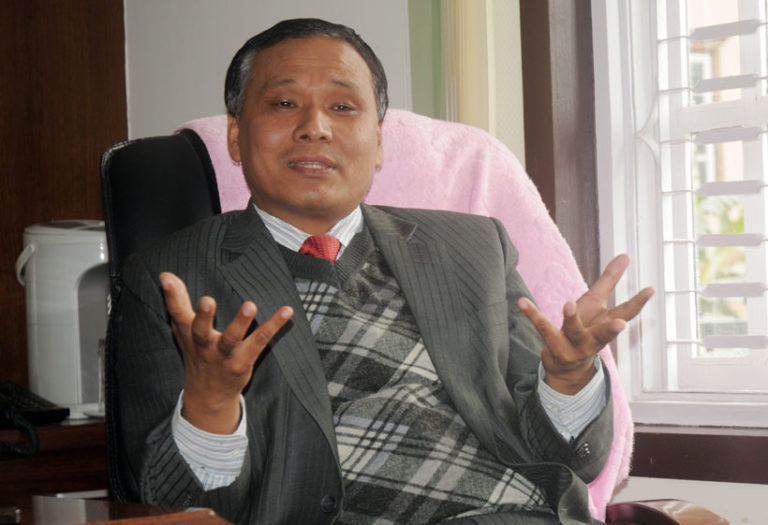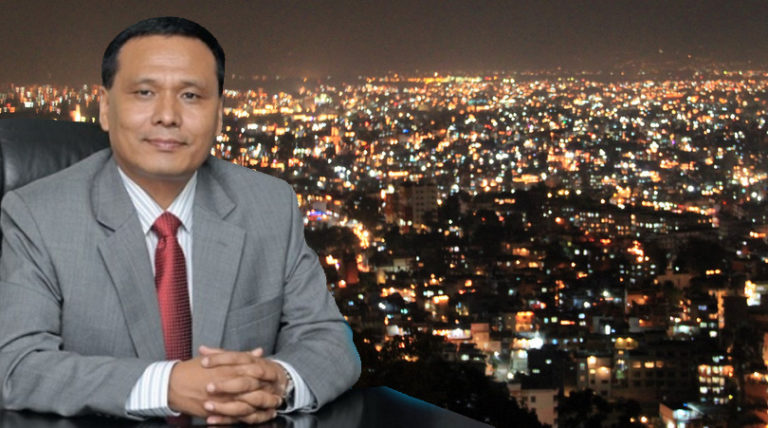Kulman Ghising : The Man Who Turned The Lights On !
Kathmandu: The term of office of Nepal Electricity Authority (NEA) Executive Director Kulman Ghising ended on Sunday. The four-year tenure of Ghising, which was announced on September 13, 2073 BS, is coming to an end on Sunday. Ghising, who arrived at NEA during 14 hours of load shedding every day, is known to have ended load shedding in the region.
Within six months of his appointment as Executive Director, Ghising had declared the Kathmandu Valley free of load-shedding after that, the major cities of the country, all household customers in the area and all domestic and industrial customers had been relieved of the load shedding on 31st Baishakh 2075 BS. During this time, he took the NEA, which had a loss of Rs.8 billion, to a strong state of increase in irrigated profits to about Rs. 5 billion.
People have been demanding the re-appointment of Kulman, who is very famous among the citizens of Nepal. Accordance with the provisions to the agreement concluded between Prime Minister KP Sharma Oli and CPN (Maoist) Executive Chairman Pushpa Kamal Dahal to repeat Ghising, the Ministry of Energy has prepared a request to re-appoint him. If the proposal is approved by the Council of Ministers, it will clear the way for the next term. It is not sure if the government will reappoint Ghising or picks anyone in his position, today’s cabinet meeting is supposed to make decision regarding leadership of the NEA.
Born on Wednesday, November 26, 2027, in a simple family in Bethan, a remote village in Ramechhap, a source of inspiration for all Nepalis and a valued personality for all, Kulman Ghising has managed to complete the long and painful load-shedding of up to 18 hours a day in Nepal Ghising, who became the executive director of the Nepal Electricity Authority (NEA) with the initial task of enlightening the homes and minds of all Nepalese, had to go through irresponsibility for any reason before being selected. At the end of the day, though, the court paved the way for his appointment and succeeded in becoming the Executive Director of the Nepal Electricity Authority. Ghising has managed to complete his campaign in these four years of tenure.
The tukis and lanterns in the villages have now been quickly displaced and the diminishing prestige of the Nepal Electricity Authority has also shone. Today, the concept of “what should not be done” has become a reality. “Impossible is only in a fool’s diary,” Ghising said. Those who say that the load shedding in Nepal will not be stopped for the rest of their lives, and no one will remove it, and if anyone removes it, they can cut off their ears and place it on their leaves, are now fighting to become the Executive Director of the Nepal Electricity Authority.
Until Kulman Ghising became the executive director of the Nepal Electricity Authority, there was total darkness in Nepal. There was load-shedding for 18 to 22 hours. The Nepalese could not see the face of electricity. There was no electricity when we slept at night, and there was no electricity when we got up in the morning. The line would have arrived at midnight and left at around 4 a.m. It was the shame of the Nepalese to cook in the dark and eat in the dark. And though some people had solar panels and inverters, the average guy was out of reach of such facilities.
The demand for batteries, inverters and solar power was very powerful. The fate of the Nepalese was to purchase batteries to keep their houses brighter, even with loans. The trade-in batteries, inverters and solar and commissioning had infiltrated Nepalese culture. The origins of the load shedding were so strong that no one even thought of saving Nepalese civilization from its swamp. Therefore, it appeared that the load shedding and commissioning problem that was rampant in Nepal could not be stopped while the Electricity Authority seemed to be busy keeping a regular load shedding schedule.
The government of Nepal did not appear to have a roadmap for a better Nepal. Corrupt members of society and those affiliated with the “free money” utility flow were fighting for commissions by supplying power to certain accessible industries. It was not easy to be the executive director of the Nepal Electricity Authority and the end the load shedding in Nepal at the time when Ghising, who became the executive director of the Nepal Electricity Authority (NEA) in such a desperate condition, embarked on the only Ujyalo Nepal initiative and succeeded in making the load shedding end completely
Ghising’s past:
- In the year 2051 BS, he officially joined the Nepal Electricity Authority from the seventh level as an engineer.
- While working in the Nepal Electricity Authority, he succeeded in becoming the managing director of Chilime Hydro Power.
- He was appointed as the Executive Director of Nepal Electricity Authority on September 13, 2008.
- He is a person believed by the then Energy Minister Janardan Sharma.
- In 2073 BS, when he was appointed, Kathmandu became load shedding free for the first time.
- In the second phase, Bharatpur and Pokhara were freed from load shedding.
- In the third phase, in 2075 BS, the whole of Nepal was freed from load shedding.
- The image of the declining authority suddenly brightened.
- The government’s trust in him, his continued support and the contribution of the NEA’s overall team made him successful.
- The big problem of power leakage has been solved and electricity consumption has increased.
- In the last four years, the Nepal Electricity Authority (NEA) has been able to make a continuous profit.
- Access to electricity has increased.
Kulman Ghising, who was committed to his faithful national service with the main purpose of a stable Nepal, including his clever Nepal campaign, had to be ridiculed in public for some of his efforts and some of his shortcomings in the fight against the various difficulties of such a dark Nepal. It would not be an exaggeration to say that being criticized for being dedicated to the service of the nation with positive thinking is a sad situation for his personal life and the nation as a whole.
What were the reasons for Ghising to be criticized? - LED: When the commission in the bulb purchase scandal had to be criticized in the controversy, he could not be present through transparency, including the reasons why he should not be involved in such controversy.
- Even though he had enough time, he could not give perfection to Upper Tamakoshi. Why he could not give perfection to Upper Tamakoshi?
- Failure to prepare concrete plan / blueprint for gas / petroleum displacement.
- The reason behind not being able to prepare a long-term basis for increasing electricity consumption was the failure to communicate one’s views on the issue.
- Why was it not implemented even though the long-term basis for the use of electrical materials was fixed by displacing the use of petrol and diesel? What was the reason for his failure? He could not express his views openly on this issue.
- Why did Director Ghising fail to rescue 36 sick hydropower projects? Did the condition of those hydropower projects get sick unintentionally? He could not come up with a clear idea, which led to his being criticized.
- Why didn’t Executive Director Ghising come up with an effective plan to increase the rate of electricity consumption? Has he been interrupted at work from somewhere? He should have been able to speak openly, where he missed.
- One of the major weaknesses of his tenure is his inability to improve the service flow of NEA’s distribution centers and hold the concerned employees accountable for their services.
- We are ready to sell electricity to India but it is said that about 14 per cent of Nepal’s population has no access to grid electricity which cannot stop Ghising from being criticized.
- Director Ghising was criticized for the sudden power outage and the inability to solve the problem of low voltage in rural and some urban areas.
- Why internal transmission lines including Solu Corridor, Kali Gandaki Corridor, Hetauda-Bharatpur Bardaghat, Singati Lamesanghu, Hetauda-Dhalkebar-Inaruwa could not be built during his tenure? He had to make it clear to everyone what was behind it. But he did not do what made him critical.
- Load shedding is over but why the distribution line has not been improved? What is the solution to the problem of cutting the line with a downpour? Director Ghising has been criticized for failing to expand the distribution system that can support loads of electrical equipment such as ACs and heaters.
- If large power projects like the 456 MW Upper Tamakoshi had been successful, not only would the Nepal Electricity Authority have benefited from his tenure today, but also Nepal would have embarked on a journey of prosperity by selling electricity to India and other countries.
Ghising’s achievements during his four-year tenure: - Financial Reforms: The Nepal Electricity Authority (NEA) has managed to earn a net profit of about Rs. 11 billion by the end of the fiscal year 2076/07. This proves that the Nepal Electricity Authority (NEA) has been continuously increasing its profits and increasing its financial governance.
- Administrative Reform: The concept of ‘Right Man Right Place’ has gained significance. There has been significant improvement in service delivery, control of electricity leakage and collection of tariff arrears. NEA has succeeded in making it information friendly. The work of generating hydropower in the company model has started.
- Production Improvement: In the Fiscal Year 2072/73, a total of 801.7 MW of hydropower was being generated in Nepal, but by the Fiscal Year 2076/77, the hydropower generation has increased by 57 per cent and reached 1258.7 MW. Significant improvements have been made in the field of power generation by continuing the construction work of the hydropower projects under construction, which have been neglected due to natural calamities and various other reasons.
- Improving power transmission: 220 KV across the country. Constructing and upgrading transmission lines such as Khimti-Dhalkewar, Kohalpur-Mahendranagar, Hetauda-Kulekhani-Suchatar and connecting remote geographical areas to the central transmission line have made significant improvements in power transmission. Nepal Electricity Authority (NEA), which started the era of profit by ending the stigma of loss, has succeeded in becoming the most profitable public corporation in the last one year.
- Improvement in Electricity Leakage Control: In the Fiscal Year 2072/07, the leakage was 25.78 per cent but by the Fiscal Year 2076/77, the electricity leakage has shrunk to 15.27 per cent. This can be considered as a significant improvement in power leakage control.
- Improvement in Electricity Consumption: In the Fiscal Year 2072/73, the annual consumption of electricity in Nepal was 3.71 billion 58 million units and in the Fiscal Year 2076/77, the total consumption reached 6.52 billion 87 million units. Overall, power consumption has increased by 80 per cent in four years.
- Improvement in access to electricity: In the Fiscal Year 2072/73, the total number of customers of Nepal Electricity Authority was around 2.9 million while in the Fiscal Year 2076/77, the total number of customers has increased to 4.8 million. Statistics show that in the last four years, an additional 23 per cent of the population has access to electricity through the national transmission.
- Distribution Improvement: Various improvements such as e-payment system, simplification in the distribution of meters and transformers, smart meter, smart grid and other services have been started to improve the quality of customer service.



